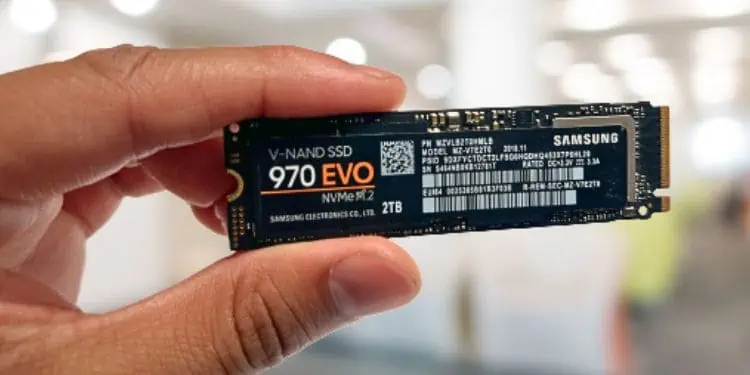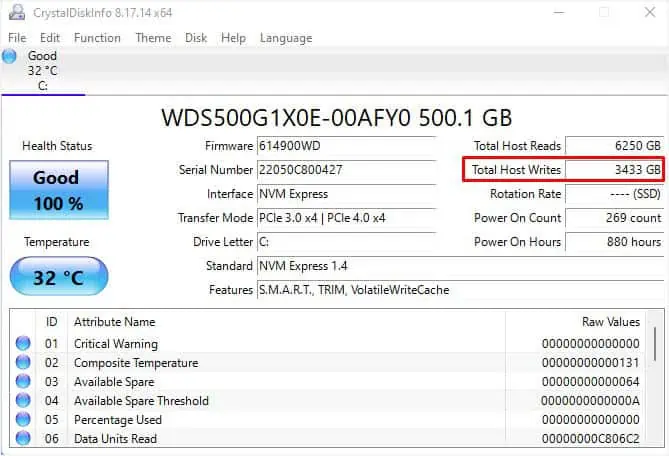SSDs are slowly becoming the optimum choice over HDDs. But one thing that has stood in its way is the uncertain lifespan. If you’re considering switching to SSD, you could be left wondering about its durability.
On average, SSDs are meant to last as long as 10 years. But this is just a myth as various factors come into play when determining its actual age. Reportedly, several researchers have concluded that the MTBF (Mean Time Between Failure) of a customer-rated SSD is 1 million hours, which is a significantly large time.
If you check the manufacturer’s specifications, you’ll likely see a different warranty period based on the model. Along with that, you might have noticed one of these terms—TBW or DWPD. So, what are these, and how well can they estimate the life of your SSD? Let’s find out.
How Long Does an SSD Last?
Before getting an SSD, we definitely inspect its warranty to know how long the manufacturer guarantees the product to last. If you have checked the specs, you’ll see three years to even ten years.
Well, this is just the warranty period and doesn’t actually tell you that the SSD will stop working after that. Along with the warranty, you might have come across terms like Period or TBW. Have a look at the specs for Samsung’s SSDs below. Some products have a low TBW (75 to 300) period, while others range from 600 to even 1200!
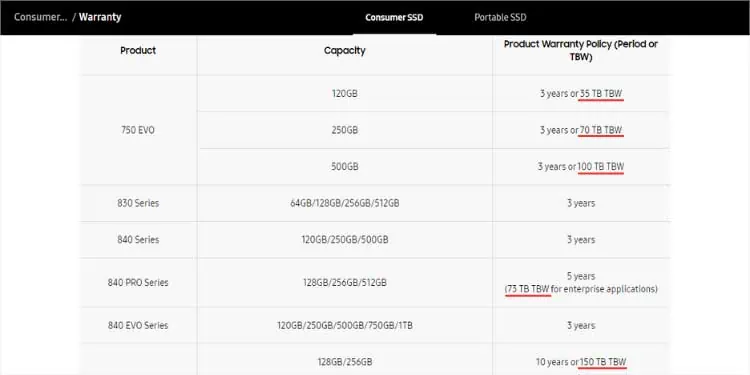
This is what tells you how long your SSD is going to last. Let’s say you have an SSD of 300 TB TBW. It means that you can write 300 Terabytes of data over the storage drive. The bigger your SSD, the higher will be the TBW rating.
While 300 could be a small value in front of 600 or 1200 TBW, it’s still much more than you can anticipate. In fact, a normal user is never going to meet this number. And what happens next if you actually write 300 Terabytes of data? Well, your SSD is not going to fail immediately. However, it will definitely degrade over time, and slowly certain sections start dying.
TBW is just a rough figure to tell you the average lifespan of an SSD. There are other measures like MTBF and DWPD. More on this later.
However, if you’re using the SSD right, you do not have to worry much! In fact, you can use the drive even more than the specified TBW. But to be on the safe side, we always recommend utilizing it only for temporary usage once the criterion is met, like storing small files or games.
Basically, there’s no answer to how long an SSD will last. You do not require replacing it often as it lasts for more than what is specified. However, it does depend on the quality (one from a reputed manufacturer is always the best), how you’re operating it, the technology it’s built upon (2D or 3D NAND), and how long you have been using it.
Does SSD Last Longer than HDD?
If you’re trying to upgrade to SSD, you might have pondered upon several questions, one being its lifespan.
Theoretically speaking, HDDs have an average lifespan of three to five years. The most important thing to note is that they have spinning discs and store data magnetically. So, it’s pretty obvious the mechanical components are more prone to failure, and the hard drive won’t last long.
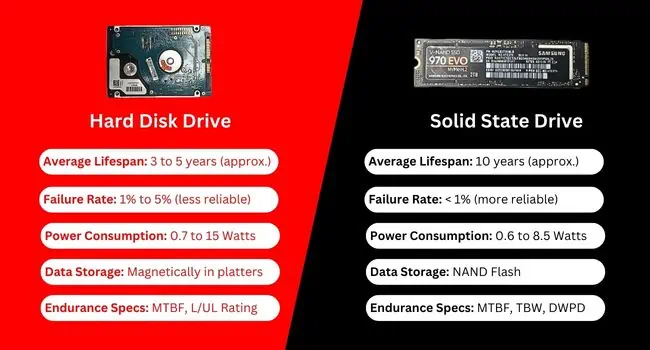
On the other side, SSDs have non-mechanical components and use NAND flash to store data. They consume less power with faster read/write speed and can store as much data as a traditional hard drive. In terms of reliability and longevity, an SSD is always the better option.
Talking about data corruption, some argue SSDs experience higher catastrophic failures. Since NAND flash saves data as blocks on electric circuits, it requires electricity to keep data stable. Therefore, if you’re not going to operate the drive for a long time, your SSD is likely to fail without even reaching its TBW period.
However, this doesn’t mean that HDDs will store data for a lifetime even without power. While it’s believed that hard drives can retain data for a long time, this could actually be a myth—its average lifespan is just three to four years.
Additionally, modern solid-state drive controllers have built-in error-correction capabilities (ECC). So, the data corruption that most users are worried about shouldn’t be a problem anymore!
Nevertheless, you should always consider keeping the SSD powered, checking its health regularly, keeping the firmware updated, and also formatting it from time to time. Do not just store the drive in your closet, hoping it to last forever.
Factors Affecting SSD Lifespan
Whether it’s an HDD or an SSD, they do not have a fixed lifetime. As stated above, certain factors can affect the longevity of these drives.
Sometimes, there are warning signs that let you know the drive is failing. It could be a notification, degradation in performance, constant freezing/crashes, and even BSODs. However, there are cases when SSDs have failed without such warnings.
P/E Cycle
The major factor that affects your SSD’s lifetime is its data write cycle and age. The more data you write in the drive, the less enduring it becomes. These can be measured using different specs—MTBF, TBW, and DWPD.
To make it simple, SSDs store data in flash memory cells, but there’s a limitation to it as well. Once all of them are full, the old data needs to be erased to add a new one. This is what we call the program/erase cycle, and it can be performed only for a certain amount of time. Once the criterion is reached, SSD is no longer reliable.
NAND Technology
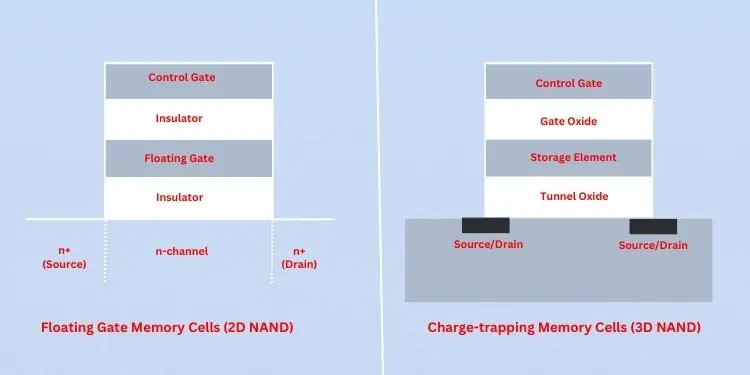
SSDs store data using NAND flash memory, which differs greatly from a hard drive. These have a grid of flash memory cells, and in every cell, 1 bit or more data can be stored, depending on the type of flash memory used. Here, data can be entered only for a certain period, and over time, it starts to degrade.
There are two types of NAND technology—2D NAND and 3D NAND, and these are nothing but just approaches to flash memory. 2D or Planar NAND uses floating gate transistors to store the bits in each cell. On the other hand, 3D or Vertical NAND utilizes charge traps to do it.
While the former stores the data side-by-side, the latter stacks them vertically (adds layer after layer, and so on). This way, more cells are stored in 3D NAND, allowing higher storage capability at faster rates.
3D NAND is the latest version that was built to improve every aspect of the 2D NAND. So, an SSD using this technology provides better endurance.
Type of Flash Memory
As mentioned above, the number of bits to be stored in a cell is determined by the type of flash memory. There are five types—SLC, MLC, TLC, QLC, and PLC (Penta Level Cell, currently in development).

Each varies in terms of endurance, reliability, cost, and performance. Some professionals even install multiple SSDs of different flash memory types (usually dual). This way, they can utilize one for achieving better performance and another for high storage. Now, let’s explore each of these types in detail.
Single Level Cell (SLC)
SLC is where only one bit of data is stored in a single cell. They have a high (around 100,000) program/erase cycle (P/E cycle), meaning it last longer than any other types that we are going to discuss below. Since the data is stored in either 1s or 0s, it’s easy to write or read the data. However, they have low storage capacity.
Since they are better in terms of performance, endurance, and reliability, they are relatively expensive. Thus, normal users might be unable to afford them, and they are best suited for commercial and industrial applications.
Multi Level Cell (MLC)
This is the type of flash memory where data is stored in two levels, meaning one cell can hold 2 bits of information. Compared to SLCs, they have a lower lifetime with around 10,000 P/E cycles. Nonetheless, they are still more reliable than TLCs and QLCs.
Since two bits of information can be stored in a single cell, it’s pretty obvious that the storage capacity on such SSDs is larger. While an MLC drive is an excellent choice in terms of price and performance, one thing to note is that they are quite sensitive to data corruption.
Note: You can even find Enterprise Multi-Level Cell (eMLC), which is simply a type of MLC for enterprise sectors. The P/E cycle is in the range of 20,000-30,000 and is in some way as effective as SLCs.
Triple Level Cell (TLC)
In TLC flash memory, three bits of data can be stored in one cell. In terms of longevity, they are better than QLC but lack far behind SLC and MLC with just a 3,000 P/E cycle.
These types of SSDs are the most abundant and can be found at low prices with high storage. As you guessed, they are not an optimal option if you seek high performance.
Quad Level Cell (QLC)
This is the latest flash memory type where a single cell can hold four bits of data. Therefore, these types of SSDs offer the highest storage but are considered to be the least effective in terms of performance and endurance.
Nonetheless, if you’re searching for high-capacity storage drives at the lowest price, QLC SSDs are just for you.
Operating Conditions
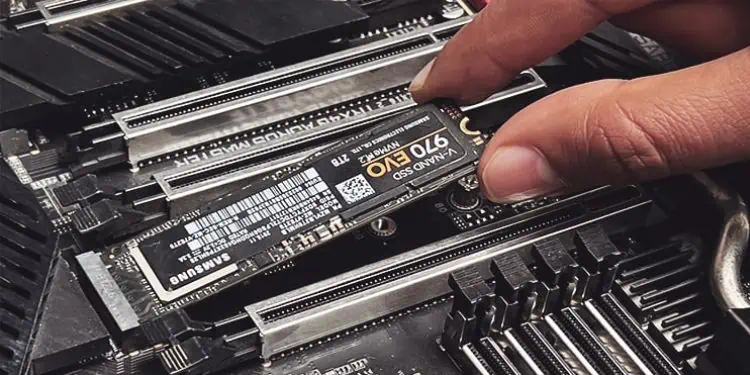
As mentioned earlier, if you’re not going to use the drive and instead prefer keeping it safe in a closet, it will do more harm than good. This is because SSDs store data in the form of electronic charges, and if there’s no power, the data might get lost.
A firmware bug is another factor that can reduce the lifespan of your SSD. For example, the “Death Bug” is known to cause permanent failures and huge amounts of data loss.
Moreover, putting too much load on the storage drive can also reduce the lifespan. If you’re a normal user, this shouldn’t be a big issue. However, if the same SSD is used in a big organization that operates on large amounts of data, the specified TBW could be met much quicker (sometimes even before the warranty period).
Lastly, SSDs should always be operated in an optimal environment. Generally, its temperature should be between 0 to 60 degrees Celsius and never exceed 70 degrees. If it does, the flash cells might decay, and there’s nothing one can do about it. To tackle this issue, we advise installing a dedicated heatsink.
Different Specifications to Measure SSD Lifespan
Now that you’re aware of the various factors that can affect the lifespan of your SSD, it’s time to move on to the different specs to measure its endurance. Note that these are just the basic estimates that manufacturers provide and give you only an insight into how long your drive might last.
Mean Time Before Failure (MTBF)
This is simply a reliability quantification index or failure rate to estimate the SSD endurance. In simple words, it’s the interval time between two failure points and is expressed in hours.
With the help of several statistical extrapolation techniques, the MTBF for most consumer-based SSD is estimated to be around 1 million hours and that for industrial SSDs is 2 million hours (1.5 million hours on average). If we convert this into years, we will get around 114 years and 228 years respectively.
Does this mean an SSD lasts a lifetime? Well, such a durability estimate on an electronic product is a myth, as different factors will eventually cause the solid-state drive to wear out before the 228 years criterion is met.
Terabytes Written (TBW)
Often referred to as Total Byte Written, this is a specification that most manufacturers use to provide a general idea of the write cycle limitation. As simple as it sounds, it’s the total number of bytes that can be written into an SSD over its lifetime.
Theoretically, you cannot write more data in your SSD once the TBW criterion is reached. But practically, it’s still possible, but as we explained above, your storage drive will start failing slowly.
For example, if the SSD showcases the specs as 300 TB TBW with 10 years warranty period, this means that you can write into the drive until the 300 Terabytes of data over 10 years.
Disk Writes Per Day (DWPD)
This is another endurance metric mainly used by manufacturers for enterprise-based SSDs. Unlike TBW, DWPS determines the number of times a user can rewrite into the drive per day over the warranty period.
Here’s a quick mathematical formula to calculate this figure:
DWPD = TBW ÷ Warranty Period in days
Let’s take the same example of the 300 TB TBW SSD with a warranty period of 10 years. Using the above formula, the DWPD of this drive would be 0.82 TB (82.19 GB). This means that you’d have to write 82.19 GB per day for the SSD to start wearing out. Indeed, this is unachievable for normal users like you and me.
How to Check the Remaining Life of SSD?
If you’re worried about surpassing the provided warranty period, it’s a good idea to check the total bytes you have written until now. This gives you an insight into how long your SSD will last.
To do so, there are plenty of open-source tools available, or you could even use the software provided by your manufacturer. Some programs only allow you to check the life remaining (in percentage).
If you want better results, you could try CrystalDiskInfo, an open-source application that lets you check the total host writes. Here’s a quick demonstration of how to use it:
- First, make sure you download the utility from the official website and install it on your computer.
- Launch it and select the SSD you wish to check. As you can see, we are using Western Digital’s SN850 NVME SSD.
- From the right column, check the Total Host Writes field. The value determines the number of GBs you have written until now. You may either convert this manually to TB or simply hover your mouse pointer over it. Ours is 3414 GB (3.334 TB).

- Now, get to your product’s specifications page or check the user manual.
- Here, look for Endurance, TBW, Warranty, or similar fields. As you can see below, the SN850 NVME SSD (500 GB) offers 300 TBW. Since we’ve used only 3.334 TB, we have miles more to go, and our SSD is going to last for several years for sure.

How to Extend the Life of SSD?
As we know, the more we write into the SSD, the more it wears out. Basically, its life is decreasing the more you use it. You might be thinking of different ways to improve or extend its endurance. Lucky for you, this is actually possible!
Wear Leveling
Most manufacturers have adopted different wear leveling algorithms that prevent an SSD from using the same cell multiple times. It provides additional space around the drive so the data can move around.
This way, the SSD life can be extended by not writing into too many cells at once. If your SSD supports wear leveling, it should already be running in the background.
Enable TRIM
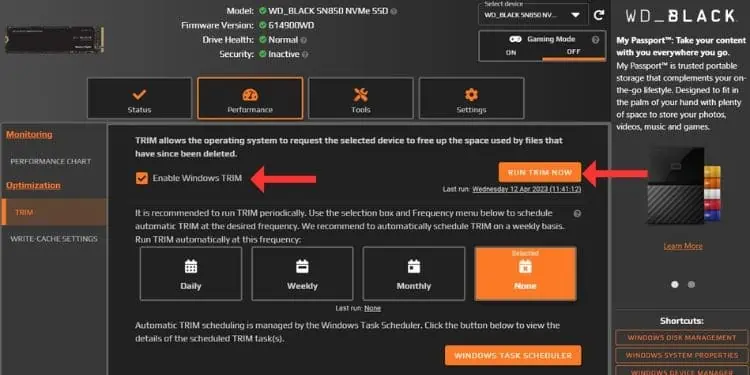
Traditionally, SSDs used a cache mechanism to delete the data, which was a slow and risky process. After the introduction of TRIM, the OS now notifies the SSD of those pages that need to be deleted. This way, data can now be written on empty pages without deleting an entire block, which can significantly help improve the SSD life.
If you haven’t enabled TRIM already, you can do this from the manufacturer’s software in just a few clicks.
Over-Provisioning Disk Space
This technique provides additional buffer space for the SSD Controller to manage the P/E cycles. The higher the overprovisioning rate, the better is for the SSD life. You can do this manually from the Disk Management utility by simply leaving 15 to 20% unpartitioned.
Bad Block Management
As the name suggests, it’s a procedure that checks for bad/unusable blocks on an SSD and replaces them with good ones. It is performed by a built-in management program in the SSD Controller, where the Bad Block Table (BBT) is constantly updated.
S.M.A.R.T Diagnostics
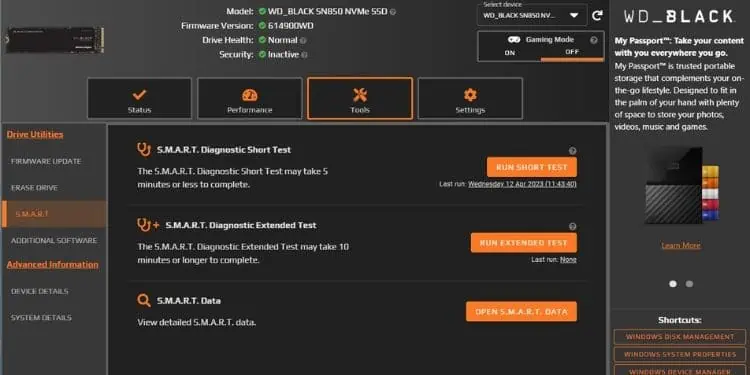
Most manufacturers offer a S.M.A.R.T tool within the product software that allows you to monitor your SSD performance, detect possible issues, and check your overall health. It’s a good idea to run a short or extended test regularly to ensure your storage drive runs optimally.
Firmware Updates
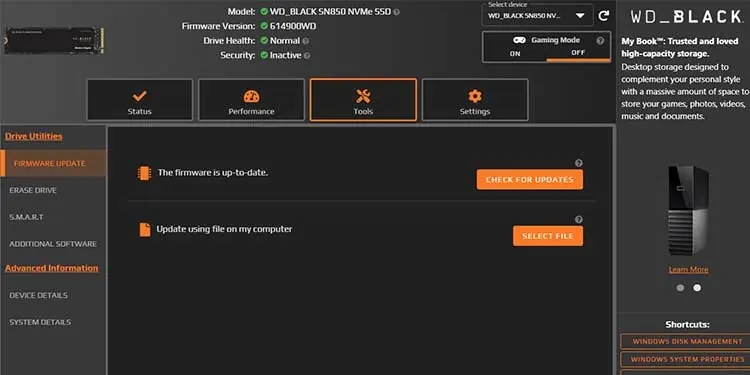
Keeping your SSD firmware updated is an excellent way to retain its lifespan. You can perform a firmware update from the manufacturer-recommended software, and it’s a relatively easy process. But before doing so, we highly recommend backing up your SSD in case of failure.
Disabling Auto Defragmentation
While disk defragmentation is the best way to allocate more space on an HDD, we do not advise performing this on your SSD. It has no positive effects on performance and could even reduce lifespan. You may go through our complete guide on why you shouldn’t defrag an SSD.
Use SSD in Optimal Environment
Since high temperatures can kill your SSD, avoid high temperatures at any cost. As discussed earlier, you may use dedicated heatsinks or even upgrade your PC’s cooling system. Also, we advise taking precautions from power outages (adding an Uninterruptible Power Supply to your setup can help) and not constantly writing on the drive.
Should I Worry About SSD Lifespan?
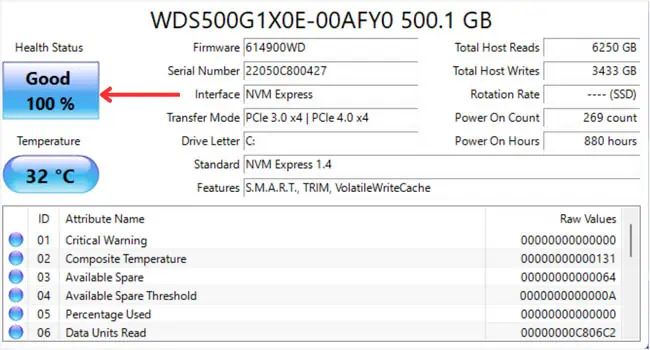
The life of an SSD varies based on the make and model, age, operating environment, and other factors. You never know when it might fail or if it’s going to last longer than what the manufacturer estimates.
Nevertheless, it’s a good idea to check the specified TBW to learn how many terabytes of data can be written over it. Even if yours has a lower value, it’s definitely not a worrying factor. Manufacturers have put on a lot of thought when building an SSD. So, it won’t die anytime soon—even if yours is halfway through the warranty period.
However, we recommend performing regular SSD health checks using the manufacturer-recommended software. If the status says Good, you do not have to worry! But in case it states Caution, know that your solid-state drive could be failing.

